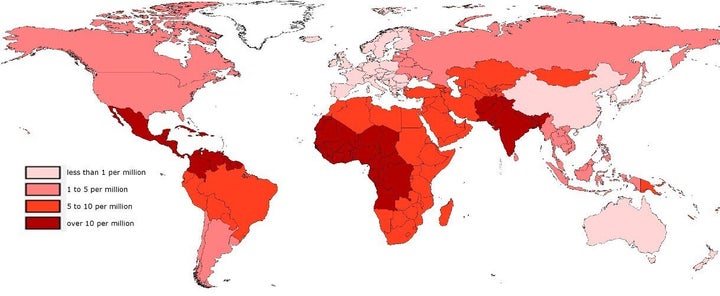Much has already been written about the tragic events of 14 December in Newtown, Connecticut. It's hard to think of anything much worse than twenty small children being gunned down just before Christmas, for doing nothing worse than attending school. But what is the global perspective on this awful event?
Coincidentally, on the same day, the Institute for Health Metrics and Evaluation (IHME) at the University of Washington in Seattle released a massive set of new estimates of causes of disease and death around the world, called the "Global Burden of Disease 2010" (GBD 2010), published in The Lancet.
I've talked about what scientists mean by estimates before - basically GBD 2010 is a set of carefully compiled "best guess" numbers using all the available data, but recognising that most deaths around the world are not properly counted, and adjusting for that. Anyway, these new estimates are the probably the best source available for looking at numbers around the world for children killed by firearms. IHME hasn't made the GBD 2010 data public on a country-by-country basis, but has published them categorised into 21 sub-regions that cover the whole world. I've used those data to make a map showing the proportions of children aged 1 to 9 years who were killed by firearms around the world in 2010.

Countries in Australasia, western Europe and parts of Asia come out clearly as the areas where children are least likely to be killed by firearms, with rates well below one per million children (palest shading). In the USA and Canada (which are combined in the IHME data), the risks are nearly 10 times greater, with several children per million being killed by firearms in 2010. This is the evidence behind current concerns in the USA: how come a seemingly successful country is getting confused between adults' rights to bear arms and children's rights to live? Clearly this remains a big political challenge for President Obama and his government.
But that is only part of the global story. What is also clear from the map is that there are large areas of the world in which children are at much greater risk of being killed by firearms than in the USA. As is so often the case in global health, broadly speaking the highest risk areas are parts of Latin America, sub-Saharan Africa and parts of Asia (over 10 per million, darkest shading). This could almost be a map of global poverty. So the global situation with children and firearms is probably an even more difficult problem to address than the domestic one currently facing America. Many of us in the global health community are working hard to reduce childhood risks of infections like malaria, diarrhoea and pneumonia - which admittedly still kill children on a far larger scale than firearms. But it seems kind of ironic that children in some of the world's poorest countries, who manage to avoid routine risks of disease and death, still face some of the highest global risks of being killed by firearms. Isn't this yet another global health problem that demands action?
